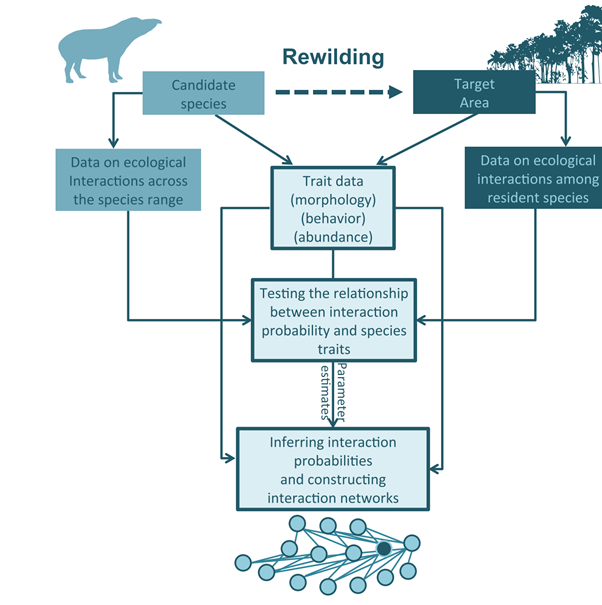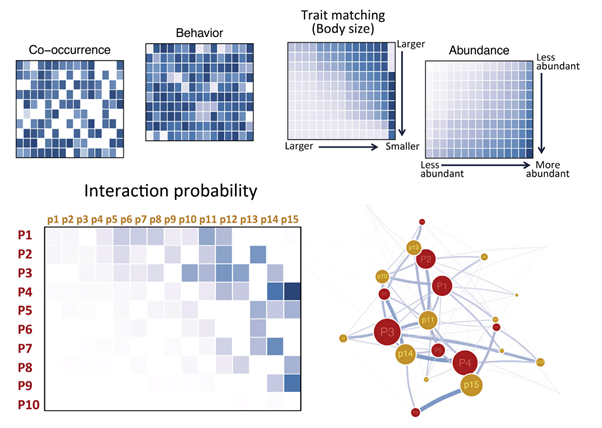1/16 Rewilding can involve species reintroductions or translocations to restore ecological processes and ecosystem function. At the centre of achieving this is the successful re-establishment of the interactions species once formed in an ecosystem (e.g. seed dispersal)
2/16 In today’s #rewilding paper, the author describes an approach for incorporating interaction networks into rewilding assessments which would predict the possibility of species restoring (i.e. ‘rewiring’) ecological interaction network structures
3/16 “To re-establish ecological processes, a rewilding project envisages rewiring an emptied food web with the desired links. Rewiring is the reconfiguration of the interaction patterns of network elements”
4/16 Conservation has shifted from being mainly species-focused to more ecosystem-focused by restoring and protecting functional ecosystems. Maintaining large and connected reserves are a good start, but the interactions between species also need to be preserved and restored
5/16 In trophic rewilding projects, the abiotic and biotic needs of a (re)introduction candidate species need to be matched to a target area. Ecosystem-wide effects of their (re)introduction should then be predicted to ensure co-existence in that particular ‘biotic context’
6/16 Adverse effects of introductions have been reported in the past, e.g. red foxes in Australia, beavers in South America, and Nile perch in Lake Victoria. From a lack of planning or assessments, unforeseen ecological effects followed in the biotic contexts they established
7/16 Alternatively, well-planned (re)introductions can be successful, with the desired outcomes occurring through the successful re-establishment of ecological interactions – these include tortoises on Mauritius and wolves in Yellowstone
8/16 The author proposes that using a network approach in rewilding, including direct and indirect interactions that would occur following species (re)introductions, could help predict reintroduction outcomes
9/16 “Examining the structure of ecological networks offers insights on the mechanisms underlying community assembly and functioning.”
10/16 Changes to network structures following extinctions and then (re)introductions can contextualize how a species will integrate into a community. Keystone species can be identified by its network centrality – including the number of species it interacts with in a community
11/16 Creating realistic and high-resolution interaction networks is time-consuming and challenging to represent as they are adaptive and dynamic systems. However, multiple forms of data could be used to create networks of interaction probabilities following reintroductions
12/16 The outcome would involve the predicted probability of an interaction forming between all pairs of species in an area. Repeated sampling of the network would give an average interaction network structure that would form following introductions
13/16 Properties of the network structure can be used to describe their stability or susceptibility to disturbances (e.g. connectance and compartmentalization) which could be used to infer dynamics before and after introductions
14/16 Interaction patterns vary through time and space. Biotic context can influence interaction effects but also population-level variation in species traits. Understanding error around interaction probabilities, or variation across specific biotic context, could be incorporated
15/16 Finally, representing all ecological interactions in nature is near impossible. However, the key assumption is that the known interactions are likely those that govern the dynamics of an ecosystem
16/16 Overall, the author provides a compelling case for integrating ecological network analysis into rewilding project assessments to predict potential outcomes of interaction rewiring following species (re)introductions
Check out the full paper here: https://www.sciencedirect.com/science/article/pii/S2530064417300834">https://www.sciencedirect.com/science/a...

 Read on Twitter
Read on Twitter




